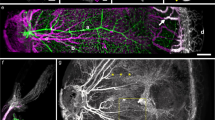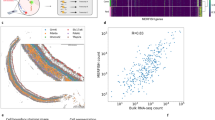Abstract
The mouse retinal vasculature provides a powerful model system for studying development and pathologies of the vasculature. Because it forms as a two-dimensional flat plexus, it is easily imaged in its entirety in whole-mount retinal preparations. In order to study molecular signaling mechanisms, it is useful to visualize the expression of specific genes in the entire vascular plexus and retina. However, in situ hybridization on whole-mount retinal preparations is problematic because isolated retinas have a tendency to curl up during hybridization and are difficult to stain. Here we provide a detailed protocol that overcomes these difficulties and visualizes the mRNA distribution of one or two genes in the context of the counterstained retinal vasculature. The protocol takes 3–4 d for single-probe stains, with an additional 2 d for immunohistochemistry co-labeling. In situ hybridization with two probes adds a further 3 d.
This is a preview of subscription content, access via your institution
Access options
Subscribe to this journal
Receive 12 print issues and online access
$259.00 per year
only $21.58 per issue
Buy this article
- Purchase on Springer Link
- Instant access to full article PDF
Prices may be subject to local taxes which are calculated during checkout




Similar content being viewed by others
References
Fruttiger, M. Development of the retinal vasculature. Angiogenesis 10, 77–88 (2007).
Gerhardt, H. et al. VEGF guides angiogenic sprouting utilizing endothelial tip cell filopodia. J. Cell Biol. 161, 1163–1177 (2003).
Geudens, I. & Gerhardt, H. Coordinating cell behaviour during blood vessel formation. Development 138, 4569–4583 (2011).
Pitulescu, M.E., Schmidt, I., Benedito, R. & Adams, R.H. Inducible gene targeting in the neonatal vasculature and analysis of retinal angiogenesis in mice. Nat. Protoc. 5, 1518–1534 (2010).
Claxton, S. et al. Efficient, inducible Cre-recombinase activation in vascular endothelium. Genesis 46, 74–80 (2008).
Connor, K.M. et al. Quantification of oxygen-induced retinopathy in the mouse: a model of vessel loss, vessel regrowth and pathological angiogenesis. Nat. Protoc. 4, 1565–1573 (2009).
Scott, A. & Fruttiger, M. Oxygen-induced retinopathy: a model for vascular pathology in the retina. Eye (Lond.) 24, 416–421 (2010).
Sawamiphak, S., Ritter, M. & Acker-Palmer, A. Preparation of retinal explant cultures to study ex vivo tip endothelial cell responses. Nat. Protoc. 5, 1659–1665 (2010).
Fruttiger, M. Development of the mouse retinal vasculature: angiogenesis versus vasculogenesis. Invest. Ophthalmol. Vis. Sci. 43, 522–527 (2002).
Claxton, S. & Fruttiger, M. Periodic Delta-like 4 expression in developing retinal arteries. Gene Expr. Patterns 5, 123–127 (2004).
Hellstrom, M. et al. Dll4 signalling through Notch1 regulates formation of tip cells during angiogenesis. Nature 445, 776–780 (2007).
Benedito, R. et al. The notch ligands Dll4 and Jagged1 have opposing effects on angiogenesis. Cell 137, 1124–1135 (2009).
Lobov, I.B. et al. Delta-like ligand 4 (Dll4) is induced by VEGF as a negative regulator of angiogenic sprouting. Proc. Natl. Acad. Sci. USA 104, 3219–3224 (2007).
Jensen, A.M. & Wallace, V.A. Expression of Sonic hedgehog and its putative role as a precursor cell mitogen in the developing mouse retina. Development 124, 363–371 (1997).
Hindges, R., McLaughlin, T., Genoud, N., Henkemeyer, M. & O′Leary, D.D. EphB forward signaling controls directional branch extension and arborization required for dorsal-ventral retinotopic mapping. Neuron 35, 475–487 (2002).
Birgbauer, E., Cowan, C.A., Sretavan, D.W. & Henkemeyer, M. Kinase independent function of EphB receptors in retinal axon pathfinding to the optic disc from dorsal but not ventral retina. Development 127, 1231–1241 (2000).
Herrington, C.S. Demystified in situ hybridisation. Mol. Pathol. 51, 8–13 (1998).
Jin, L. & Lloyd, R.V. In situ hybridization: methods and applications. J. Clin. Lab Anal. 11, 2–9 (1997).
Sambrook, J. & Russell, D.W. Protocol 6: synthesis of single-stranded RNA probes by in vitro transcription. in Molecular Cloning: A Laboratory Manual (Cold Spring Harbor Laboratory Press, 2001).
Thisse, C. & Thisse, B. High-resolution in situ hybridization to whole-mount zebrafish embryos. Nat. Protoc. 3, 59–69 (2008).
David, R. & Wedlich, D. PCR-based RNA probes: a quick and sensitive method to improve whole mount embryo in situ hybridizations. Biotechniques 30, 769–772, 74 (2001).
Nagy, A., Gertsenstein, M., Vintersten, K. & Behringer, R.R. Techniques for visualizing gene products, cells, tissues and organ systems. in Manipulating the Mouse Embryo (eds. Nagy, A. et al.) (Cold Spring Harbor Laboratory Press, 2003).
Acknowledgements
We are grateful to N. Pringle for many helpful tips during the development of this protocol. This work was supported by grants from the MRC (G0501711), The Wellcome Trust (WT086511MA) and the Lowy Medical Research Institute.
Author information
Authors and Affiliations
Contributions
All authors contributed to the development of the protocol and M.B.P., K.V., J.A.G.M. and M.F. wrote the manuscript.
Corresponding author
Ethics declarations
Competing interests
The authors declare no competing financial interests.
Rights and permissions
About this article
Cite this article
Powner, M., Vevis, K., McKenzie, J. et al. Visualization of gene expression in whole mouse retina by in situ hybridization. Nat Protoc 7, 1086–1096 (2012). https://doi.org/10.1038/nprot.2012.050
Published:
Issue Date:
DOI: https://doi.org/10.1038/nprot.2012.050
This article is cited by
-
Cre toxicity in mouse models of cardiovascular physiology and disease
Nature Cardiovascular Research (2022)
-
Molecular signatures of retinal ganglion cells revealed through single cell profiling
Scientific Reports (2019)
-
Consensus guidelines for the use and interpretation of angiogenesis assays
Angiogenesis (2018)
-
Plastic roles of pericytes in the blood–retinal barrier
Nature Communications (2017)
-
PDGFRβ-P2A-CreERT2 mice: a genetic tool to target pericytes in angiogenesis
Angiogenesis (2017)
Comments
By submitting a comment you agree to abide by our Terms and Community Guidelines. If you find something abusive or that does not comply with our terms or guidelines please flag it as inappropriate.



